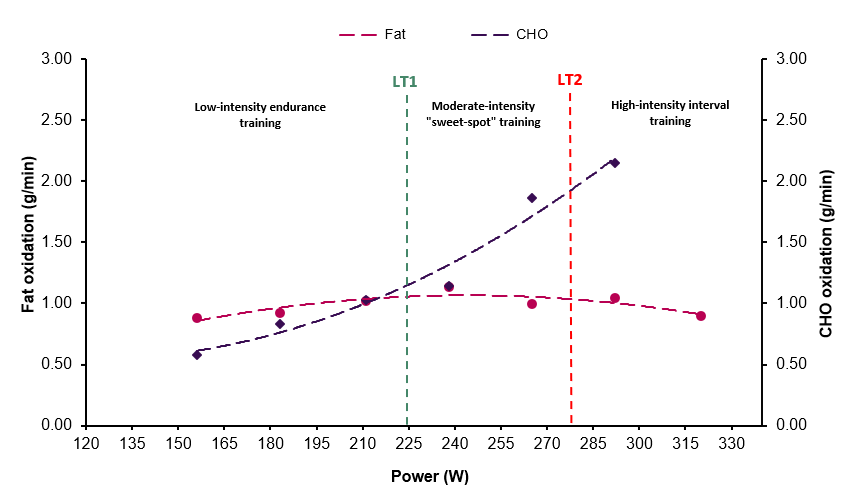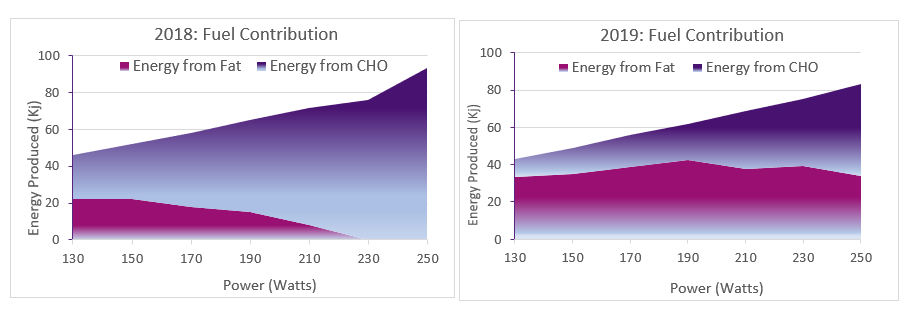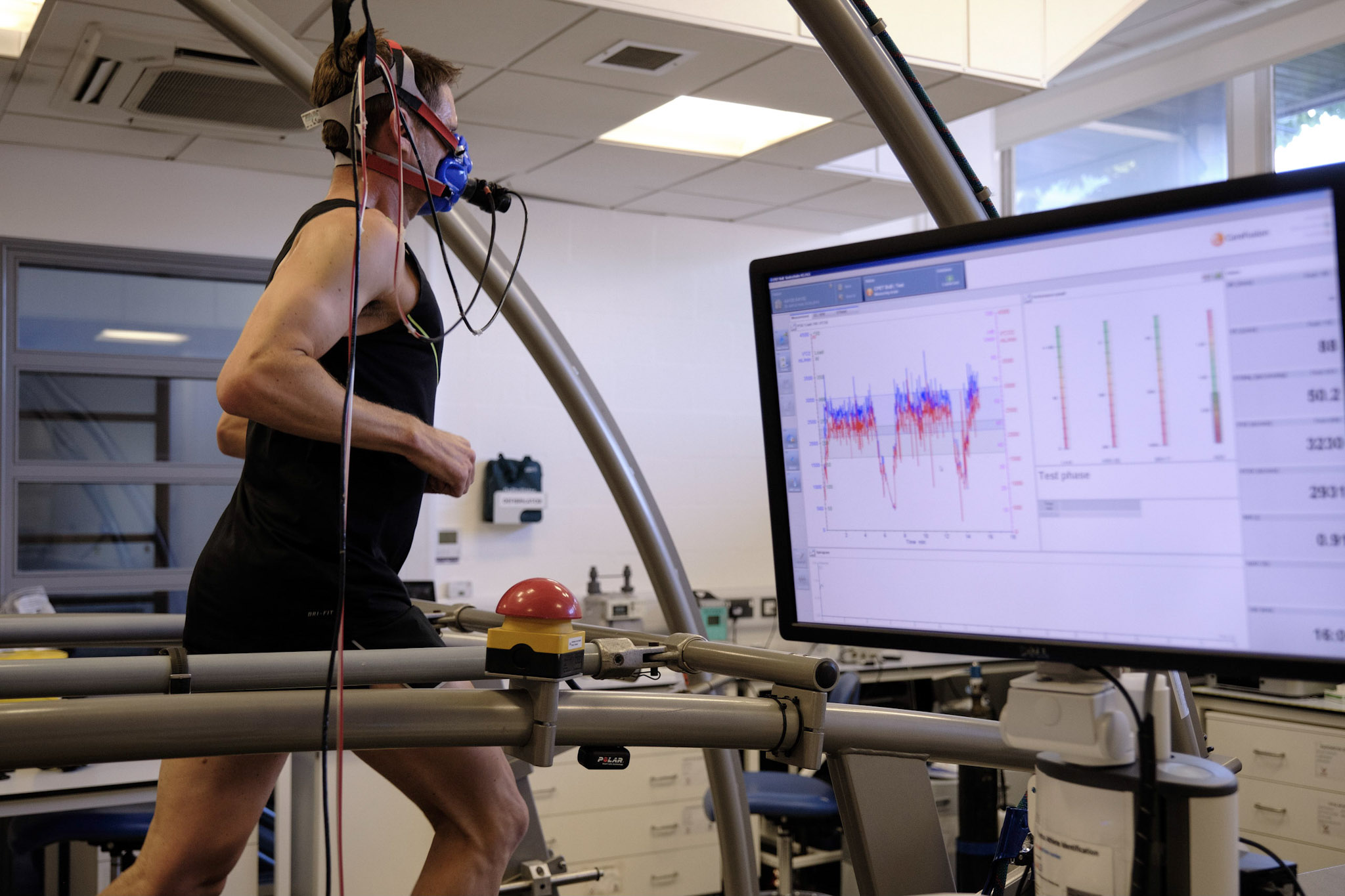Ironman/Triathlon/Ultra-endurance competition requires enormous energy expenditure; the ability to maintain a steady performance largely depends on adequate fuel supply.
Understanding how your body burns fuel during activity is paramount to success in these events.
Where Do We Get Energy From?
During exercise athletes predominantly rely on carbohydrates (CHO) and fats to fuel an activity. The relative contribution of each is determined primarily by the intensity and duration of exercise, alongside training and nutritional status.
In the human body, endogenous carbohydrates are stored as glycogen in skeletal muscle and the liver. However, storage is finite taking up around 3000 kcal; long-duration events can deplete the body’s glycogen stores resulting in fatigue otherwise known as “bonking” or “hitting the wall.” Nevertheless, CHO is a readily available substrate for ‘fast’ energy and is the main energy source during moderate-high intensity activity.
In contrast, human fat reserves are essentially unlimited in the context of exercise, even in very lean individuals. For example, a 75kg athlete with 15% body fat, can store up to around 100,000 kcal, indicating that fat stores are not going to run out during exercise! Fats are broken down slower than glycogen and are therefore more valuable during lower intensity, long-duration events. With the potential to manipulate the rate at which CHO stores are depleted during ultra-endurance sport, this might indicate the duration at which a given exercise intensity can be sustained.
The graph below illustrates the interaction between fats and CHO at progressive exercise intensities indicated by power (W). Fats provide the greatest energy contribution at lower intensities (below LT1) and with each progressive power output, CHO increases linearly, particularly beyond LT2 when the body is predominantly relying on endogenous CHO to fuel the activity.

Fat oxidation graph
Why can’t athletes simply consume a high quantity of CHO before/during an event?
Ingesting CHO from sports drinks and gels is a common strategy used by athletes throughout endurance events. Although this reduces the body’s reliance on finite CHO stores, the rate of absorption across the gut has shown to be limited. For that reason, high rates of exogenous CHO consumption before and during an event can lead to debilitating gastrointestinal (GI) symptoms, where some athletes may not finish the race as a result.
An alternative approach is to undertake diet and training strategies that elevate the potential for fat oxidation during exercise. Given the substantial capacity for human fat reserves, this could be a potent strategy to reduce the body’s reliance on stored, endogenous CHO, negating the need to fuel high quantities during a race and thus reducing the risk of GI distress.
Additionally, the ability to tap into fat reserves for energy is pertinent for Ironman and Ultra-endurance athletes since success is often metabolically limited rather than fitness limited. In other words, a capacity to generate high levels of energy throughout an event is what makes the difference in a competition, irrespective of how ‘fit’ the athlete is. This is sometimes seen when short-course Triathletes make the jump to Ironman events and struggle, despite being very aerobically fit.
Testing
So, we understand the importance of fuel (specifically fat) utilisation, but how do we test it?
The only feasible way to assess individual fuel contribution is to do a metabolic exercise test in the Physiology Lab. This is sometimes referred to as ‘Metabolic Efficiency Testing’ or ‘Fat Oxidation Testing’, all of which encompass similar principles of using indirect calorimetry during graded exercise.
Metabolic testing can either be performed on a bike or treadmill starting off at a low intensity, below LT1. This is to ensure baseline fuel utilization is captured. As described previously, starting at too high an intensity will elicit a heavier reliance on carbohydrates, thus limiting the amount of information obtained regarding an individual’s fat utilization. The test will gradually progress in 6-minute stages with each stage presenting a slight increase in intensity. 6-minute stages are used to allow an athlete to physiologically adjust to the new intensity, reaching what is known as ‘steady state’ exercise. At this point, variables such as heart rate, blood lactate, oxygen consumption and fuel utilization can be measured accurately, with a focus on the final minute of each stage.
Depending on the individual, their event and level of training, the test should last around 6-7 stages to fully encapsulate a metabolic profile.
Throughout testing a face mask is worn, connected to an online gas analyser, which assesses the amount and percentage component of gases expired during breathing (as shown in the image above). Collection and analysis of expired gases in this way is known as indirect calorimetry and allows identification of substrate utilization by analysing oxygen consumption and carbon dioxide production at steady state. Alongside gas concentrations, a key element of data collection is the Respiratory Exchange Ratio (RER).
This is the ratio of the volume of carbon dioxide produced versus oxygen consumed at each progressive intensity. RER provides an estimate of the proportion of energy being provided by either CHO or fat; more oxygen is required to breakdown fat compared to CHO (to burn 1g of CHO, approximately 0.81L of oxygen is required versus 1.96L per gram of fat). When RER is closer to 1.0, the body relies more heavily on carbohydrates, however when RER is closer to 0.7 the body is metabolising a greater proportion of fats to fuel the activity. Gas analysis is key to highlighting differences in oxygen consumption and carbon dioxide production, ultimately indicating fuel metabolism.
Testing will highlight the intensity at which maximal fat oxidation is observed (Fatmax), expressed as a percentage of VO2max. Moreover, Maximal Fat Oxidation (MFO) is the maximum rate of fat oxidation, expressed in grams per minute (g/min). Metabolic testing can provide relevant and impactful data for performance when well-planned and repeated.
Characterising an individual’s metabolic profile in terms of MFO and Fatmax can provide further insights into the strengths and weaknesses of their performance which can result in targeted training and dietary interventions to further enhance performance. Various research suggests that training at/around such intensities, where metabolic pathways involved in fat metabolism are maximally activated, could result in optimal adaptations for fat-burning.
What We Can Do…
Our emphasis on metabolic testing and understanding an athlete’s fuel utilisation is to examine trends and changes over time. Data will indicate MFO (g/min) as well as Fatmax, expressed as a % of your VO2max. Illustrating metabolic changes will allow us to advise you how to manipulate training to enhance physiological adaptations and subsequently improve performance. You will receive a bespoke, detailed report outlining your overall physiology in a user-friendly format.
Below is an example of some test data collected from an Ironman athlete 1 year apart:

two graphs showing Fuel contribution
As you can see, the relative energy contribution from fat has increased markedly in 1 year, whilst CHO metabolism has been suppressed, reducing the athlete’s reliance on CHO.
In the example above, Mark Pearce (the coach) from Intelligent Triathlon Training, wanted to obtain information on fuel utilisation because the athlete was finding it very difficult to sustain the expected intensity in a half-Ironman race. The initial test revealed his fat utilisation was poor, with carbohydrates being the dominant fuel source even at relatively low intensities. Therefore, Mark was confident that in a race the athlete was running out of carbohydrates, despite fuelling well and therefore having to reduce intensity. Following the test, Mark put a training and nutrition strategy in place to improve this area and we re-tested the athlete 1 year later.
Anecdotally, the athlete found unfuelled training sessions much easier than prior to the intervention however the testing enabled Mark to observe the magnitude of the improvement, allowing him to decide whether this was an area to continue working on, or simply maintain. As a result, the athlete’s half-ironman run performance improved by 10 minutes with minimal change in threshold speed.
Considerations for Metabolic Testing
At Loughborough Sport everything is research-driven, particularly with regards to physiological testing. However, metabolic testing presents a few potential pitfalls that should be considered.
Within the research it is widely accepted that consuming a pre-exercise high-carbohydrate beverage/meal elevates CHO-burning, suppresses fat oxidation, and will therefore directly impact testing. Research in this area usually involves testing athletes in the fasted state (i.e testing in the morning having not eaten since the previous evening). This is designed to reflect an athlete’s ‘raw’ underlying physiology not influenced via acute perturbations (such as nutrient status), whilst also allowing for athlete comparison by means of standardisation.However, it is unlikely that an athlete would begin an event without having consumed anything and, with this method, there is no consideration for fuel taken on during the event.
Another option would be to attend the lab in a fed state i.e having consumed a standard pre-race meal prior to testing. This would be more replicable to race-day, highlighting how your body physiologically operates during an event. Nevertheless, this method still presents issues around the idea of fuelling during the event and, for Ironman Triathlon, does not appreciate the completion of 3 different disciplines. To go one step further, testing could be completed after a long training session (i.e attending the lab having just completed a long bike/run, incorporating fuelling strategies) with the aim of replicating a similar state of physiological stress observed in competition. However, in practice, implementing a long day of training and testing poses more of a logistical challenge.
It is important to note that there isn’t a single ‘correct’ method to tackle this; it becomes more a question of what you would like to achieve from Metabolic Testing and how it will inform preparation for an event i.e understanding your ‘baseline’ physiology versus understanding how your physiology behaves in competition.
The ‘Cross Over Concept’ is a parameter often presented from metabolic testing. The cross-over is the exercise intensity at which the energy provided by fat and carbohydrate oxidation is equal and thus at exercise intensities above this, an individual starts to predominantly utilise carbohydrate to fuel exercise. The application of this concept is that the higher exercise intensity this ‘cross-over’ occurs, the higher the workload the individual can work at before they start to rely predominantly on carbohydrates.
However research consistently shows highly trained endurance athletes rely less on carbohydrate for fuel, even at higher exercise intensities and therefore a ‘crossover’ may not be observed during metabolic testing due to the relatively low intensities used. Equally this concept has not been considered in research in relation to performance, therefore the usefulness of the cross-over point to characterise an athlete is yet to be thoroughly established. Stronger evidence suggests that MFO correlates well with ultra-endurance performance, hence why Loughborough Sport puts a focus on this parameter as part of testing.
Endurance events, particularly Ironman, present many variables that impact fuel use including nutritional intake, variation in race intensity, the influence of heat and hormonal variation in females, to name a few. Therefore, an athlete’s test feedback will not indicate specific fuelling strategies to adopt in competition and training i.e stating “if you use Xg/min of CHO or fat at your race intensity then you should aim to fuel Xg/hour during the event.” Athletes and coaches should avoid using test results in isolation to manipulate training, but rather should look to monitor trends and changes over time, for example assessing relative energy contributions off the back of a training block.
Another aspect to mention is the validity and reliability of the testing equipment. Gas exchange analysis can be conducted either offline using Douglas Bags or by online breath-by-breath analysis, the latter being the method used by Loughborough Sport Physiology. Douglas Bags are considered the ‘gold standard’ technique and are more commonly used in a research setting because the equipment is highly accurate. However, the use of Douglas Bags is time-consuming owing to the requirement of sampling and analysis post-collection, amongst several other limitations.
Online gas analysers are advantageous because they provide oxygen consumption data in real-time, allowing for constant monitoring of an athlete’s progress throughout a physiological test. Nevertheless, the accuracy of this method for determining fuel use has been questioned. At Loughborough Sport we are currently undergoing a validation study, comparing the online gas analyser method with the use of Douglas Bags to mitigate any technological errors and refine the testing procedure.
In summary, a vast amount of research in this area suggests there is large day-to-day variation when estimating MFO and Fatmax, a conclusion found to be consistent for different genders, physical activity levels and cardiorespiratory fitness. Nevertheless, certain variables could be attributable to this finding, including discrepancies in methodology, testing protocols and pre-test standardisation, such as nutrient status and acute physical activity.
Minimising the carbohydrate cost associated with performing at competitive intensities whilst enhancing the body’s reliance on fats for fuel should be a major focus of Ironman/Ultra-endurance preparation. Doing so will delay fatigue associated with glycogen depletion, otherwise known as “bonking” or “hitting the wall”, whilst reducing the need to fuel high quantities of CHO, thus avoiding GI distress.
Metabolic Testing in the Physiology Lab is therefore key to understanding how your body burns fuel, highlighting how you can optimise training and nutrition to ultimately improve your performance in these events.
If you would like further information, or would be interested in doing these tests, please contact us.
References
- Achten & Jeukendrup (2010) - Fatmax: A new concept to optimise fat oxidation during exercise?
- Achten & Jeukendrup (2010) - The effect of pre-exercise carbohydrate feedings on the intensity that elicits maximal fat oxidation
- Carter & Jeukendrup (2002) - Validity and reliability of three commercially available breath-by-breath respiratory systems
- Coggan (1997) - The Glucose Crossover Concept Is Not an Important New Concept in Exercise Metabolism
- Frandsen et al. (2017) - Maximal Fat Oxidation is Related to Performance in an Ironman Triathlon
- Gonzalez et al. (2016) - Liver glycogen metabolism during and after prolonged endurance-type exercise
- Kilding et al. (2018) - Contextualising maximal fat oxidation during exercise: determinants and normative values
- Maunder & Plews (2020) - Should I train my gut? Both sides of the coin on preserving endogenous carbohydrates
- Maunder et al. (2018) - Substrate metabolism during ironman triathlon: different horses on the same courses
